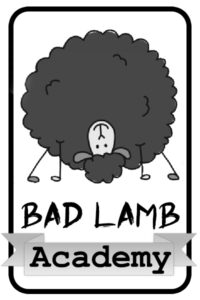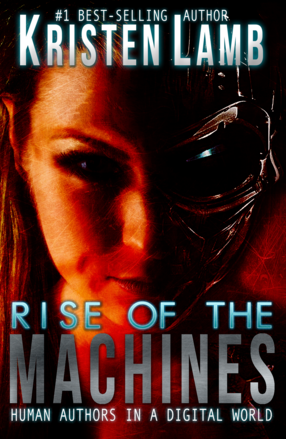Happy Monday, my peeps. Today we are going to talk some more about the antagonist. The antagonist is THE most critical element of our fiction. Yes, even more important than the protagonist. Blasphemy! No, I’m serious. Our protagonist cannot become a hero (heroine) without the antagonist. No opposition and no story.
Yet, every time I blog about the antagonist, I get the same comments:
But what if nature is the antagonist?
But what if a belief system is the antagonist?
But what if my protagonist and antagonist are the same person?
Most of the time, questions like this alert me that you have slept since high school or college English. Do not feel badly about not knowing this stuff. The English we are taught in school is not meant as preparation for a career in commercial fiction. I struggled with this stuff, too, which is why I am using this blog to help part the fog of confusion.
Today we are going to talk about Man Against Nature, since many new writers believe that bad weather, a hungry bear or a Shark-Clown can be the antagonist (or the BBT if you read last week’s post). Yes, they can, but uh, not really. If we want our story to have more depth than a Hollywood B movie, we need to really understand this Man Against Nature thing and how to make it work.
But First, Man Against Man
Man Against Man is fairly straight-forward. This is probably the simplest form of story antagonism to see and understand. In simple Man Against Man, we have an antagonist who has a goal that conflicts with the protagonist’s goal.
In the Chronicles of Riddick, Lord Marshall wants Riddick dead because Riddick is the last Furian male, and a Furian male is prophesied to bring Lord Marshall’s end. Riddick, however, wants Lord Marshall dead because Lord Marshall wiped out Riddick’s planet trying to kill all the Furian males so that he could stop the prophesy.
A smidge of irony there.
So here the conflict is pretty clear. Lord Marshall wants Riddick dead and Riddick wants Lord Marshall dead. Only one of them can be dead at the end of the story, lest this become a French film and be hailed as genius at the Cannes Film Festival.
Everybody died, even the houseplants! It was brilliant!
Thus, all of Lord Marshall’s actions are to capture and kill Riddick. All of Riddick’s actions are to avoid capture but press closer to take out Lord Marshall. It is this tug-of-war that creates the story tension.
Ah, But What About Man Against Nature?
Okay, to start. How many NYT best-belling novels have we seen where the protagonist is fighting bad weather for 400 pages? And how can a protagonist ever really win against the weather? It isn’t something we can control, so is the weather really the BBT (Big Boss Trouble-Maker)?
Yes, and no.
Often Man Against Nature will also generate a Man Against Man and a Man Against Himself story.
Huh?
I know. It’s okay. Breathe in a paper bag and trust me. First, understand that even if a storm or a shark-clown is the BBT, we need a corporeal antagonist to generate much of the conflict.
Humans don’t do so great with existentialism.
Thus, your story likely will lend itself more to a character battle. What is it about your protagonist that will change when pitted against nature or the worst parts of himself? There will often be a flesh and blood representation of that ugly nature.
The Perfect Storm
The Wolfgang Peterson film The Perfect Storm is a great example. Was the storm really the BBT? Or was it merely a catalyst that brought forth the real BBT…pride and greed (Man Against Himself).
George Clooney plays Captain Billy Tyne who is desperate for money. Tyne convinces the crew of the Andrea Gail to go fishing during a dangerous time of year to preserve his business and his pride (and frankly, the men agree because they are desperate, broke and trying to preserve their manhood).
The crew presses out beyond their normal fishing grounds, leaving a nasty developing thunderstorm behind. Their luck seems to improve when they hit the Flemish Gap. The men bring in the haul of a lifetime…but then ice machine breaks.
Of course it does!
There are but two choices—go through the storm of the century to get home before the fish rot OR go around the storm but lose the haul and their dignity. A fight breaks out among the crew (Man Against Man). Some want to take on the storm. Others know it’s a fool’s errand and no money is worth dying for.
Ultimately, it is the captain who makes the final decision to risk his men for the fish. He is the physical proxy of greed and pride. He (mistakenly) believes believes that their skill will be able to triumph over the perfect storm, and he is wrong and everyone dies…which is probably why I really didn’t care for the book or the movie, but that is just me.
But, notice how the storm doesn’t directly generate the story problem. The captain is broke. He is staring down the barrel of bankruptcy. The men are broke. They are fighting with loved ones over bills.
It is pride and greed that propel the men out into the ocean during the most dangerous time of year. Pride and greed drive them beyond their normal fishing area. And, in the end, pride and greed lands them at the bottom of the ocean.
It is the captain who leads the way, and that is why HE is the proxy of the BBT. It is his decision to go fishing during a dangerous time of year that changes everything. If Tyne had declared bankruptcy and taken on selling hand-painted garden gnomes, there would be no story and the men would have lived.
Yes, this can be a mind-bender, but practice this enough and it gets easy.
Man Against Hungry Critters
Another great example of Man Against Nature is the 1997 survival story The Edge. Anthony Hopkins plays braniac billionaire Charles Morse who becomes stranded in the wilds of North America when the small prop plane he’s traveling in crashes. Charles is not alone. Though the pilot is killed, two photographers–Bob and Stephen–survive with Charles.
If this were a simple Man Against Nature story it would still be good, but what makes it great is the story doesn’t stop there.
Man Against Munchies Man
Charles is aware that photographer Bob is having an affair with Charles’s wife (a supermodel). He also suspects that Bob deliberately invited him out into the wilds to kill him. This agenda is, of course, put on the back burner due to the fact that Bob is a total city boy and he needs Charles’s photographic memory if he hopes to survive.
***Charles loves reading survival books and Bob is in a pickle without that information running around Charles’s noggin.
Man Against Himself
Charles is a billionaire, a man with the Midas touch. His mind is what has helped him amass a fortune, but he’s never really had to get his hands dirty. When he crash-lands in the wilderness with a man he knows wants him dead, can he do what it takes to come out alive? Nature is what will test this.
See, Nature becomes the catalyst–the brutal weather and sparse food of the Pacific Northwest. Oh, and add in a hungry man-eating bear and now we have the perfect test for Charles, to see what he is really made of.
This movie isn’t scene after scene of fighting off a bear and keeping warm–though there is a lot of that. The fighting the weather and evading the bear really drive the Man Against Man story. Charles vs. Bob. Only one man can walk out alive.
Thus, I hope you can see that Man Against Nature is doable. Mother Nature is a viable choice for a BBT, but she does need help for our story to have any depth. In The Edge, screenwriter David Mamet could have written a script where characters outran a bear for 90 minutes…but he didn’t, and THAT is why the movie rocks.
Next week we will explore some more unconventional antagonists. Did this help? Are your brains now the consistency of scrambled eggs? Any questions? What are some questions or troubles you have with the antagonist?
I LOVE hearing from you!
And to prove it and show my love, for the month of April/May, everyone who leaves a comment I will put your name in a hat. If you comment and link back to my blog on your blog, you get your name in the hat twice. If you leave a comment, and link back to my blog, and mention my book We Are Not Alone in your blog…you get your name in the hat THREE times. What do you win? The unvarnished truth from yours truly.
I will pick a winner every week for a critique of your first five pages. At the end of April/May I will pick a winner for the grand prize. A free critique from me on the first 15 pages of your novel. Good luck!
Note–My plane got in late and I didn’t get to bed until midnight. Will announce the winner either Wednesday of Friday. Thanks :D.
I also hope you pick up copies of my best-selling books We Are Not Alone–The Writer’s Guide to Social Media and Are You There, Blog? It’s Me, Writer . And both are recommended by the hottest agents and biggest authors in the biz. My methods teach you how to make building your author platform FUN. Build a platform and still have time left to write great books.








34 comments
4 pings
Skip to comment form
Excellent post, Kristen. I’m a big believer in the antagonist having some human face, a figure who can be defeated to represent the protagonist’s eventual victory. it’s kind of why The Lord of the Rings always fell a bit flat with me. The war against Sauron was Man against Nature, because Sauron is so far detached from human concerns, to the point of not even having a physical presence, that he can’t be considered a villain in and of himself. There’s no focal point for the heroes’ efforts and in the end, evil sort of defeats itself because its Gollum’s desire for the ring that stops Frodo from escaping with it.
I think the antagonist needs to have a relatable presence. If the audience can’t pinpoint the antagonist and say “That! That’s the guy I hate!” then it’s harder to really get behind the protagonist’s efforts.
“Everybody died, even the houseplants! It was brilliant!”- I’m laughing because I love that type of over dramatic ending. One of my favorite shows of all time was a Canadian vampire tv series. Did I like it because it was all that good? No, because it was merely mediocre. I loved it because everyone died at the end. It’s been almost twenty years since I’ve seen it, and I’m still gushing. Fortunately, I stop myself from doing that to my own characters.
You must be wrong, I am my own antagonist and I’m in a huge galactic solar storm. Lol
Funny coincidence, Writing Excuses just talked about the same thing recently.
They made the point that when nature’s the BBT, it helps if the protagonist has a goal within the context of the story. IE, usually disaster movies are Man vs. Nature, but the protagonist’s goal could be to rescue his kids in the face of the disaster, something more than just surviving the storm.
I don’t know that I’m quite ready to tackle a man vs. nature story yet, but it’s definitely food for thought that the big bad can be nature, but there’s usually smaller antagonists getting in the way of the MCs goal.
“Breathe in a paper bag and trust me.”
That made me laugh. I want to shout from the mountain tops, “Just do what Kristen says!” I guess I drank the KLamb Kool-Aid long ago. Awesome post about humanizing the antagonist.
Sound advice, as always.
Thinking about what you have said has made me realise that I have set into a pattern over virtually all my novels of keeping the antagonist a mystery for most of the book, and that perhaps I am overdoing that particular approach. The protagonists are contending against the results of the antagonism, without knowing where it comes from.
Author
That should only be Act One. Larry Brooks says in Act One, the protag is running. She is striking at shadows, unsure what has disrupted her life. Act Two, the protag is now a warrior. She is fighting back. Act three the protagonist becomes the Hero. Literally the story could end at the Darkest Moment (right before turning point to Act III). Most people would quit, but heroes do no. What makes the character a hero is he presses on to the Big Boss Battle.
Makes sense. Like all ‘rules’, of course, they are there to be broken – as long as the breaking works. I think it did so very well in the first, where the identity was only revealed after the final battle, but I am in danger of developing a set pattern which – though many successful authors seem to use them – means that after the first book one shouldn’t bother with reading any further ones unless heavily into theme and variations.
Great information! I liked the way you sprinkled humor throughout. The paper bag comment made me laugh too.
This post might apply equally to war stories where “the enemy” never actually acquires an individual identity. What does a fighter pilot, for example, see of his enemy? Nowadays, rarely more than a blip on the radarscope, but even in WW2 hardly more than a head with helmet and goggles peeking out of a cockpit. However, most stories like that (a good example might be James Salter’s book The Hunters, and the film by the same name) have exactly the sort of man v. man, or man v. himself, interactions you describe above.
very interesting and I plan to follow and learn more!
Kristen, I love your humor! And a good reminder that I need to pay closer attention to my antagonist.
“Everybody died, even the houseplants! It was brilliant!” LMAO
Chronicles of Riddick was greatly underrated IMHO – how can that be, when not only did he succeed against the odds, he killed a violent bully WITH HIS TEACUP??!!
Very nicely articulated. I didn’t like The Perfect Storm either – yeah, yeah, the ending may be more gritty and soi-disant ‘real’, but if I wanted ‘real’ I’d turn on the news.
Actually, I bet The Perfect Storm went down, well, a storm in France – “Everyone died! Even the houseplants! It was brilliant!” (Well, they might have had a little potted cactus propped up somewhere)
I’d love to mention your blog on my blog, but mine deals specifically with my trials and tribulations as a Highland athlete, so… meh. Not sure I can work that in there!
Author
Just mention me when you blog about what you do in the meantime, LOL. Glad you liked :D.
Love this! Was something I was thinking about recently as I read a book that had a lot of Man v. Badluck. It wasn’t working until Badluck got a face attached to it.
Also, I felt like a Kristen Lamb groupie this weekend at the Arkansas SCBWI when I was mingling and another writer mentioned “Bob Meyer”. My antennae went up.
“Do you follow Kristen Lamb?” I inquired.
“I’m a big fan of Kristen!” The other replied.
We hit it off and had a wonderful gush together about your awesome blog. Then of course, we shared all your blog contact info with everyone else in the circle so they could bask in your wonderfulness!
It was a very fun moment.
Author
Yay! How surreal for you. I really appreciate the fandom and the sharing the WANA love!
Such a great synopsis of antagonist vs. protagonist. I love your wit, it’s awesome, and VERY CLEAR! I think I’m off to buy your books (I know, shame on me should’ve already done that).
You got some good stuff going here.
“Only one of them can be dead at the end of the story, lest this become a French film and be hailed as genius at the Cannes Film Festival…Everybody died, even the houseplants! It was brilliant!”
OK, I not only laughed out loud, I read it to my mother!
I think you’ve made a lot of good points, and almost every book I can think of supports your points. But when someone says “man vs. nature,” the first book I think of is Hatchet, by Gary Paulsen. The kid’s got issues, but the plane crashes in the Alaska wilderness, the pilot is dead, and it’s a straight-forward, well-written story of physical and psychological survival.
I haven’t read it for a few years, so I may be mis-remembering. Is this the exception to the rule? Or is there another conflict with a “face” that I’ve missed?
Looking forward to more laugh-out-loud comments!
My fiction muscles are still little baby bumps in training so I would NEVER even attempt a Man vs. Nature thinking it would be way too hard. I’m all about Man (or Woman) vs. Man or Man vs. Himself. It’s more straightforward and fun to me. 🙂
I always have trouble with the antagonist thing. It’s starting to get clearer thanks to your explanations. I couldn’t even do those worksheets in high school where we had to put the protagonist and antagonist and all that stuff about the books we were reading. Thanks for this series of posts, Kristen!
I think that you’ve made mush of my brain, if only because I’m laughing too hard to think! I await the next installment to see if it makes more sense to me, but I know that I should have the patience to look back at my favorite novels and see if I can ID the BBT in them.
This instantly made me think of Twister for some reason.
Yes the people make the story, not really nature. Or any other form of “big thing”.
In a story I’ve been writing on there this organization that could be seen as the “bad guy”, but that doesn’t really work. So I pretty much start out with a small scale problem and work from there.
I also find man against man more interesting to read anyway.
As a child I loved reading books like Call of the Wild by Jack London, and classics like Black Beauty and The Jungle Book. I prefer to write books however that have very straightforward antagonist vs protagonist scenarios. I guess, like Jenny said, I consider myself too much of a beginner to tackle anything else at this stage. Although I’ve been writing for years, it’s only been in the last 5-10 that I’ve really begun to grasp more of the real underlying dynamics of how to write fiction. So at this stage at any rate, I try to stick to what feels the most organic. The thought of writing man vs nature is terrifying! That being said, keep these posts coming Kristen, it’s all fuel for the fire!!
Yvette Carol
Different culture 🙂
Wayne
I, too, love that line: “Only one of the can be dead at the end of the story…”
Hi Kristen!
My favorite film of Man VS. Nature was the film “White Squall” with Jeff Bridges. Only this time it was Jeff Bridges who was the BBT (Man VS. Man) instead of George Clooney. Bit my fingernails off with this one. But then, do we really want to compare Jeff to George? Jeff has my vote! 🙂
I’ve nominated you for the versatile blogger award! Congratulations! http://versatilebloggeraward.wordpress.com/vba-rules/
Incredibly clear statement of Man vs. Nature, Kristen. You, Larry Brooks, and Bob Mayer have really helped me with understanding the antagonist at a helicopter level. I struggle with it on the page–“it’s the antagonist, stupid” is a well-used mantra of mine–but the good news is I recognize it, and I am patient. For me, your posts on antagonists do not have an equal.
As always, thanks.
Karen
Nice analysis of how different subplots drive and enhance the main plot. The story may be man against a storm, but the drama comes from why man is out in the storm in the first place. Thanks!
I haven’t read all the comments, so pardon me if I repeat things. Have any of you seen the recent film, “The Grey”? It stars Liam on-a-jet-ski Neeson as a down-on-his-luck, suicidal badass (Ottway) whose job is protecting a siberian oil rig from natural predators, namely wolves. The plane going home crashes and the survivors have to battle hungry wolves, bitter winter, and each other. It’s an amazing man v. nature (v. self) film that totally creeped me out and reinforced why I hate cold weather.
It’s ultimately about Ottway’s will to live. The opening voice-over shows him wanting to kill himself for something we don’t know all the details about. After the crash, he’s the one who knows how to survive in the deadly wilderness. And in the end, he has to decide how he will die. (P.S. there’s a scene after the credits and I hate hate hate it so much.)
Anyhow, the physical representations of nature are the wolves, who hunt down the men with ruthless efficacy. The horrible situations bering out the man v. man, with various characters representing Greed, Fear, Insecurity, and even Hope. We see the dwindling survivors fighting to remain human in the face of bestial conditions.
At the beginning of the film, Ottway wants to die. By the end of the film, he’s experienced so much death that he could justifiably lay down in the snow. But that makes for a French classic, and this is America. We want Big Damn Heroes, and Ottway does not disappoint.
IMO, the Antag/BBT is just another way to Make It Happen. “The Grey” is about Ottway’s life: keep it or toss it? “Perfect Storm” is about business: go for broke or go broke? The Antag serves as a device to prevent the desirable ending from occurring. Conflict, hence Plot.
I love your blog. I’m working on two manuscripts at once and don’t have time for blogs, but I read yours. Why? It makes sense to me. Unfortunately i just realized my antagonist is totally wimpy and no threat to anyone. I just downloaded your book onto my Kindle. I need all the help I can get. Jan Addington.
I know it’s been said above but it’s a great overview of man vs man and man vs nature to understand how to build dramatic tension. Thank you!
[…] TV Tropes Monday: Crapsack World 30 Apr Tweet of the Day: Man Against Nature-How to Make it Work […]
[…] Man against nature – how to make it work by Kristen Lamb What parts of your life are not homogenized, pasteurized, FDA-approved, plastic-wrapped, unscented, tasteless, pablum? by Holly Lisle […]
[…] Man Against Nature – How to make it work by the ever-fabulous Kristen Lamb. […]
[…] Man Against Nature – How to Make It Work, The Key Ingredient for Dramatic Tension – Understanding the Antagonist, and Dare to Be Uniquely You – Final Thoughts About Voice — Kristen Lamb […]